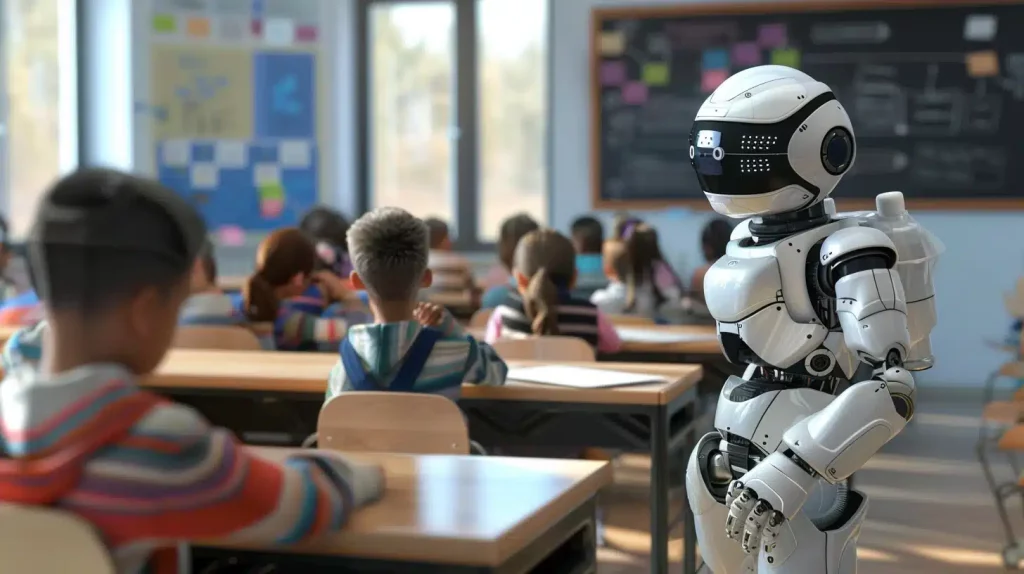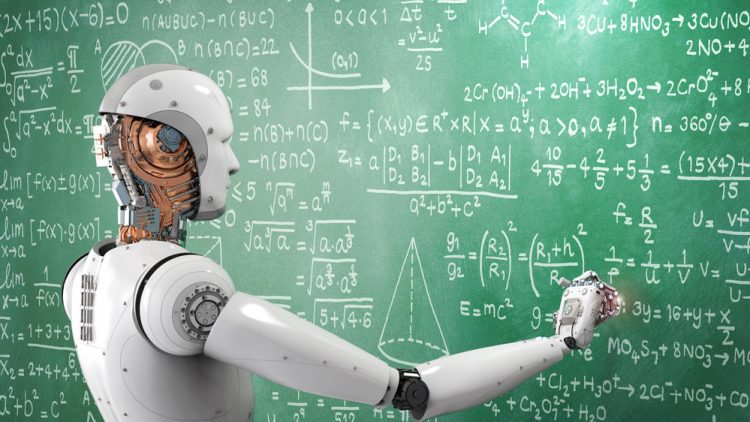Introduction: The Dawn of a New Educational Era
The rapid development and widespread adoption of robotics and artificial intelligence (AI) are set to revolutionize the education sector in profound ways. Historically, education systems have been slow to change, with traditional teaching methods and pedagogies dominating classrooms for centuries. However, as technology advances, the integration of robots and AI is beginning to disrupt these long-established norms.
AI-powered systems are already being used in various fields, from healthcare and finance to entertainment and transportation. In the education sector, robots and AI are enabling more personalized, adaptive, and interactive learning experiences. They can analyze students’ learning patterns, provide real-time feedback, and even simulate complex scenarios to enhance critical thinking and problem-solving abilities.
The use of robots in education isn’t just about automating administrative tasks or offering digital teaching assistants. It’s about transforming how learning is delivered and experienced by students, educators, and institutions. From early education to higher learning and corporate training, the applications of robotics and AI are expanding across all levels of education. This article explores the current and future impact of these technologies on the education sector, focusing on the transformative potential, benefits, challenges, and ethical considerations.
1. Robotics and AI in the Classroom: A New Frontier in Learning
1.1. The Role of AI in Personalized Education
One of the most significant ways AI is transforming education is through personalization. Traditional classrooms are often designed to cater to a one-size-fits-all model, where students of varying abilities are taught at the same pace. However, not all students learn the same way, and this disparity can lead to gaps in understanding.
AI has the ability to adapt content to individual learning styles, allowing for a more tailored approach. For example, AI-based systems can analyze a student’s progress in real-time, identifying strengths and weaknesses, and then provide resources, exercises, or alternative explanations to help them overcome challenges. This personalized learning experience helps students stay engaged, motivated, and on track with their educational goals.
Furthermore, AI can provide immediate feedback on assignments and assessments, allowing students to understand their mistakes and improve without waiting for a teacher’s review. This instantaneous feedback mechanism supports active learning and enhances the learning process by promoting self-correction.
1.2. Collaborative Robots and AI Learning Assistants
The integration of robots in classrooms is another innovative application that is gaining traction. Robots can serve as learning assistants, offering interactive support to both students and teachers. For younger learners, educational robots like Bee-Bots or LEGO Mindstorms can help teach basic concepts in math, science, and programming. These robots can engage students with hands-on activities that are both fun and educational, fostering a deeper understanding of abstract concepts.
At the higher education level, robots and AI can assist with more complex tasks such as data analysis, research assistance, and even virtual tutoring. Some universities are already experimenting with robots that can assist students in writing essays or designing projects by offering suggestions, recommendations, and resources that fit the student’s progress and interests.
1.3. Virtual and Augmented Reality for Immersive Learning
Another significant innovation that AI and robotics bring to education is the rise of virtual and augmented reality (VR/AR). These technologies allow students to explore subjects in immersive environments, something that was previously impossible with traditional textbooks or static media.
For example, students studying history can visit ancient civilizations or explore historical events in virtual settings. Likewise, students studying biology can simulate and interact with complex biological systems, observing cellular activities or navigating the human circulatory system in 3D. This type of interactive and experiential learning has the potential to increase retention, deepen understanding, and spark creativity.
2. Robotics and AI in Special Education
2.1. Supporting Students with Disabilities
Robotics and AI also hold significant promise for special education, offering new ways to support students with disabilities. For children with autism, robots can provide structured environments and social interaction that might be difficult to achieve with humans alone. AI systems can analyze and predict a student’s needs, adjusting teaching strategies accordingly to provide a more inclusive educational experience.
For students with physical disabilities, assistive robots can provide physical support, helping them navigate classrooms, carry materials, or engage in physical activities. Robots equipped with AI can also be used to track progress and adapt activities to ensure students with disabilities receive tailored educational experiences that suit their unique challenges.
2.2. Enhancing Emotional Learning
In addition to academic support, robots and AI systems are increasingly being used to help students with emotional intelligence and social skills development. For children with learning difficulties or emotional disorders, robots can serve as neutral and non-judgmental companions. These robots are designed to interact in ways that promote emotional well-being, helping students build confidence and work on social interactions.
For instance, AI-based social robots like KASPAR have been used in therapy to teach children with autism how to recognize emotions and engage in social communication. These robots are able to replicate social cues in a controlled, predictable manner, which is crucial for children who might find human interactions overwhelming.

3. The Benefits of AI and Robotics in Education
3.1. Increased Access and Equity
One of the most promising aspects of AI and robotics in education is their potential to increase access to high-quality education. With the rise of online learning platforms powered by AI, students from all corners of the world can access personalized learning experiences that were previously reserved for elite educational institutions.
For remote or underserved communities, robots can serve as remote teachers, providing instruction in places where human teachers might be scarce. In some cases, robots can even facilitate language learning, breaking down communication barriers between students and instructors who may speak different languages.
Furthermore, the cost of robotic systems and AI-based learning tools is steadily decreasing, making them more accessible to a wider range of schools, colleges, and universities. As the technology becomes more affordable, the gap between wealthy and poorer educational institutions could narrow, providing equal learning opportunities for all.
3.2. Scalability and Efficiency
AI-powered systems can handle a significant number of students simultaneously, which means that they can support large-scale educational initiatives. Whether in classrooms, online platforms, or hybrid learning environments, robots and AI can provide scalable solutions to teach more students without compromising on quality. AI-based tutoring systems can manage thousands of students at once, offering personalized feedback and support to each individual.
Moreover, robots can automate many time-consuming administrative tasks for teachers and administrators, such as grading assignments, tracking student progress, and organizing classroom activities. This enables educators to focus more on interactive teaching and student engagement, ultimately improving the quality of education.
3.3. Real-World Learning Opportunities
Robots and AI can simulate real-world situations and problems, offering students the opportunity to engage in applied learning. Whether it’s using AI to solve mathematical equations, conducting science experiments with the help of robotic assistants, or creating engineering prototypes with robots, students can gain hands-on experience with technologies that are revolutionizing industries.
These experiences are critical for preparing students for the future workforce, where proficiency in AI, robotics, and data science will be essential. Robotics education also fosters critical thinking, problem-solving, and creativity, all of which are highly valued in today’s economy.
4. The Challenges and Ethical Considerations
4.1. Privacy and Data Security
As AI and robotics become more integrated into education, data security and privacy will be critical concerns. AI systems often collect and process vast amounts of student data to personalize the learning experience. Ensuring that this data is kept safe, secure, and used ethically will be paramount in building trust between educators, students, and technology providers.
There are also concerns about the misuse of student data, especially in contexts where students are tracked and profiled based on their academic performance or behavior. To address these concerns, robust regulations and data protection policies must be put in place to ensure that AI systems respect student privacy and adhere to ethical guidelines.
4.2. Teacher and Student Adaptation
The integration of AI and robotics into classrooms will require a shift in educational practices. Teachers must be trained to work alongside these technologies, adapting their teaching methods to leverage the strengths of robots and AI systems. This transition may be challenging for some educators, particularly those who are less familiar with digital tools.
For students, there is also the potential for over-reliance on technology, which could diminish human interaction and collaboration. Striking the right balance between digital tools and traditional teaching methods will be key to ensuring a well-rounded education.
Conclusion: A Transformative Future for Education
As robot technology and AI continue to evolve, they will undoubtedly play a central role in the future of education. From personalized learning to assistive technologies, the potential benefits are vast. However, with these opportunities come significant challenges that need to be addressed—particularly around privacy, security, and the role of educators.
To fully realize the promise of AI and robotics in education, collaboration between educators, technologists, policymakers, and students will be essential. By integrating these technologies thoughtfully and ethically, we can create a future where education is more accessible, engaging, and tailored to the needs of each individual.
As we look ahead, it’s clear that robotics and AI will not just enhance education; they will redefine it. The next generation of learners will experience education in ways that were once thought impossible, and robots will be an integral part of that transformation.







































